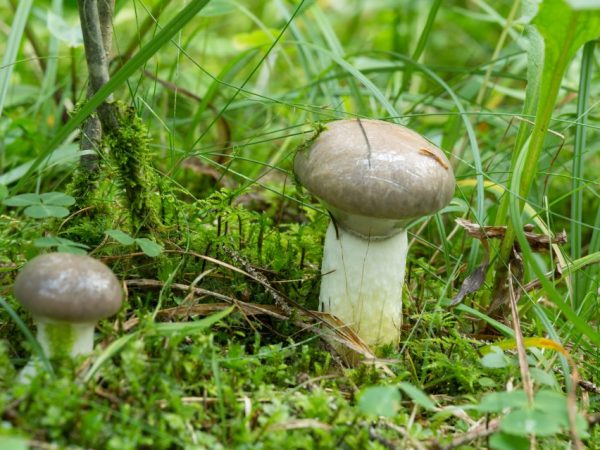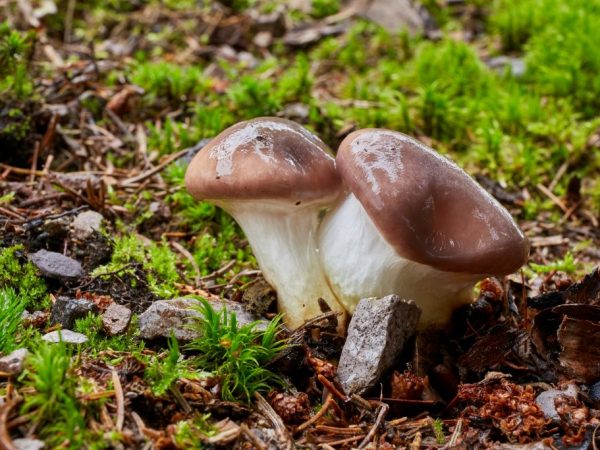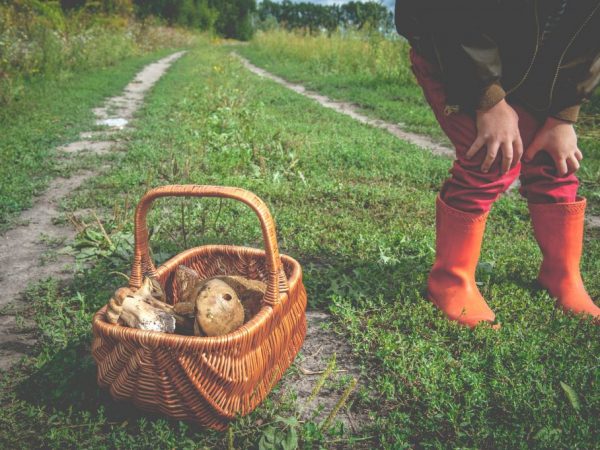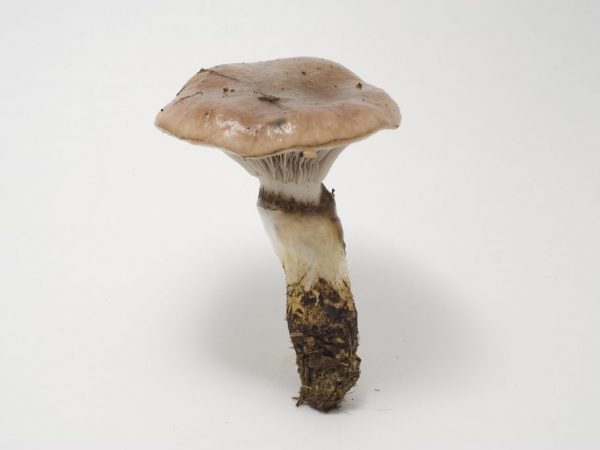Description of the mokruha mushroom
The moss mushroom has a nondescript appearance and looks like a toadstool, but it is edible, tasty and healthy. Its only difference is that with any culinary processing it turns black, so mokruha is undeservedly crossed out from the long list of forest delicacies desirable for mushroom pickers. In a systematic respect, the mokrukhs are included in the Gomfidia family, or Mokrukhivs and belong to the Chroogomfus genus.

Description of the mokruha mushroom
Characteristics of the fungus
Mokruha (or "slug") looks like a russula. It also belongs to the lamellar species of mushrooms and often has bright multi-colored caps (pink, purple, lilac). Scientists-mycologists during a series of genetic studies have established that the closest relatives of this fungus are boletus.
The Mokruha mushroom has a leg, the description of which will help a novice hunter to identify it in the forest. It tapers slightly downward, and at the very base it is always colored yellow (orange), which makes it stand out from other fruiting bodies. For this reason, she was given another name - yellow-footed wormwood.
According to the description, the hat of the "slug" is also peculiar. From above it has a cone-shaped protrusion, in the form of a pimple. Young fruiting bodies have a lot of mucous substance on the cap. It also covers the entire surface of the caps of adults. In dry hot weather, this mucus dries up. The flesh always turns pink when cut.

Mokruha looks like a russula
Description of varieties
Mokruha pink
Mokruha is pink - its cap is colored, depending on age, in coral, purple, brick colors, fading in the center. With age, the edges gradually bend upward, dark spots appear on the surface. The pulp is white, it turns pink at the cut, but when cooked it becomes hopelessly dark. The pulp tastes sweet, the smell is pleasant. There is even more squirrel in it than in boletus.
Irina Selyutina (Biologist):
The edible species of pink moss is widespread in Eurasia. Due to its rare occurrence, the mushroom is included in the Red Data Books of a number of countries, such as Belgium, Bulgaria, Hungary, Poland. The fungus is a mycorrhizal forming fungus (mycorrhiza) with pines. Interestingly, growing next to the goat (Suillus bovinus), pink moss began to parasitize on its mycelium in the process of evolution.
The species is characterized by the rapid disappearance of the private veil, which first connects the cap to the leg. From it, only a Volvo-shaped ring remains on the leg.
It grows next to a pine tree, often comes across mushroom pickers in mountainous areas. Mokruha pink looks like russula, but pink mokruha is of a completely different genus. It appears at the end of summer and bears fruit until October.
Mokruha spotted
The cap is pale, has brown spots. Mokruha spotted grows in coniferous or mixed forests. The spotted color may not appear on the cap immediately. Young fruiting bodies often do not have it. The leg of the spotted moss is whitish or yellowish; it turns red upon contact with atmospheric oxygen.In the stem, the pulp is fibrous. The surface of the leg is sticky, there is a mucous ring on it. Above - white or spotted, below - yellow.
The spotted variety often coexists with spruce wood. They are often seen side by side in the same meadow.
Irina Selyutina (Biologist):
In mokruha, the spruce cap has an average diameter of 4-10 cm. It is convex or outstretched, usually curled or slightly depressed in the center, with a curled edge. The skin, like other species, is covered with a layer of mucus. The skin itself is smooth, dark brown, a purple tint is noticeable along the edges of the cap, sometimes black spots may appear at a later age. Hymenophore plates are whitish at first, in mature specimens they are purple-brown, or even black. Young fruiting bodies are covered with a private veil for quite a long time. From it subsequently remains a rapidly disappearing mucous ring on the leg.
Spotted moss has the same taste as other types of mushrooms. This species forms mycorrhiza with conifers such as spruce and larch. Distributed in North America and Eurasia.
Mokruha felt
The legs are orange (hence another name is yellow-footed), the caps are olive. Found in coniferous forests or mixed. Felt moss got its name from the small whitish downy that is present on the cap. In addition to common conifers, it forms a symbiosis with whole-leaved or black fir.
According to the description, felt wool is common in the Far East and North America. In the central part of Russia, it is extremely rare. Felt moss is also an edible and useful mushroom, but due to its limited growth, it is unknown among mushroom pickers and therefore is little used.
Useful properties and application
The chemical composition of the slug allows it to be used not only in cooking, but also in medicine. The mushroom has long been known for its nutritional and medicinal properties.
| Calorie content, kcal | 19,5 |
| B (proteins, g) | 0,95 |
| F (fats, g) | 0,42 |
| U (carbohydrates, g) | 3,3 |

The mushroom is known for its nutritional and medicinal properties
In cooking
The "slug" becomes edible after preliminary heat treatment. It is better to marinate, salt, fry, cook sauces with it, add to salads. Before preparing a culinary dish from the "slug", the hat must be thoroughly cleaned of the film and, accordingly, mucus. Store fresh mushroom mass in the refrigerator for no more than a day. During this period, the product retains its natural properties.
For frying, "slugs" are not pre-boiled. It is enough to clean them from the film and rinse well in water.
Wash the slugs thoroughly. Some of their species grow on sandy soils, so a large number of microscopic particles of debris stick or get stuck between the plates on the fruit body.
In our country, "slugs" are not very popular. They are believed to be poisonous and bypassed. The external resemblance of "slugs" to toadstools played an important role in this. Only seasoned mushroom pickers, who do not like to return from the forest with an empty basket, pick them up and prepare delicious nutritious dishes, pickle or pickle for the winter. In Europe, on the contrary, it is a popular delicacy and is widely used in cooking, occupying a niche corresponding to its taste.
In medicine
In home treatment, a tincture is prepared from slugs. The drug has pronounced antimicrobial properties. Often in the forest they see that the hat of the "slug" has been eaten by some animal. Mushrooms serve as an inhabitant of the thicket as a kind of pills, with which they are treated for colds, worms, and other infectious problems.
The film covering the slug cap helps to heal wounds. To remove it completely without damaging it, it is worth cutting the fruit body from bottom to top. In this case, the film must not be touched with a knife blade.Carefully remove the formed two halves of the fruiting body. Apply the film layer to the wound, fix it.

In home treatment, a tincture is prepared from slugs
Traditional medicine attributes a whole range of medicinal properties:
- Memory is strengthened.
- Chronic fatigue is eliminated.
- The body's defenses are growing.
- Diseases of a viral nature are defeated.
- The processes of hematopoiesis are improved.
- Headache, insomnia, nervous disorders disappear.
Slug mushrooms are useful for caring for your appearance. Cosmetic preparations based on them help to maintain youthfulness of the skin, its elasticity, shine and hair health. In a vegetarian diet, slugs are a substitute for meat, since they are rich in proteins. Their low calorie content allows them to be used in diets for people suffering from obesity and diabetes.
Contraindications
Although this mushroom is edible, it will not be useful for everyone. Its use should be avoided by children and people with gastrointestinal disorders. The substance chitin contained in the mushroom pulp is absorbed with great difficulty by the digestive tract. Do not abuse "slugs" for people with gout. In addition, for people with allergies, it is important to know that mokruha mushrooms can cause Quincke's edema.
To avoid complications, you should not collect fruit bodies in an industrial area, near highways, dumps and other environmentally unfavorable places.
Conclusion
Mokruha is unknown to most mushroom pickers. The yellow-leg appearance and other features of the fungus make it possible to unmistakably distinguish it from other fruiting bodies. You can collect it without fear of poisonous doubles.



